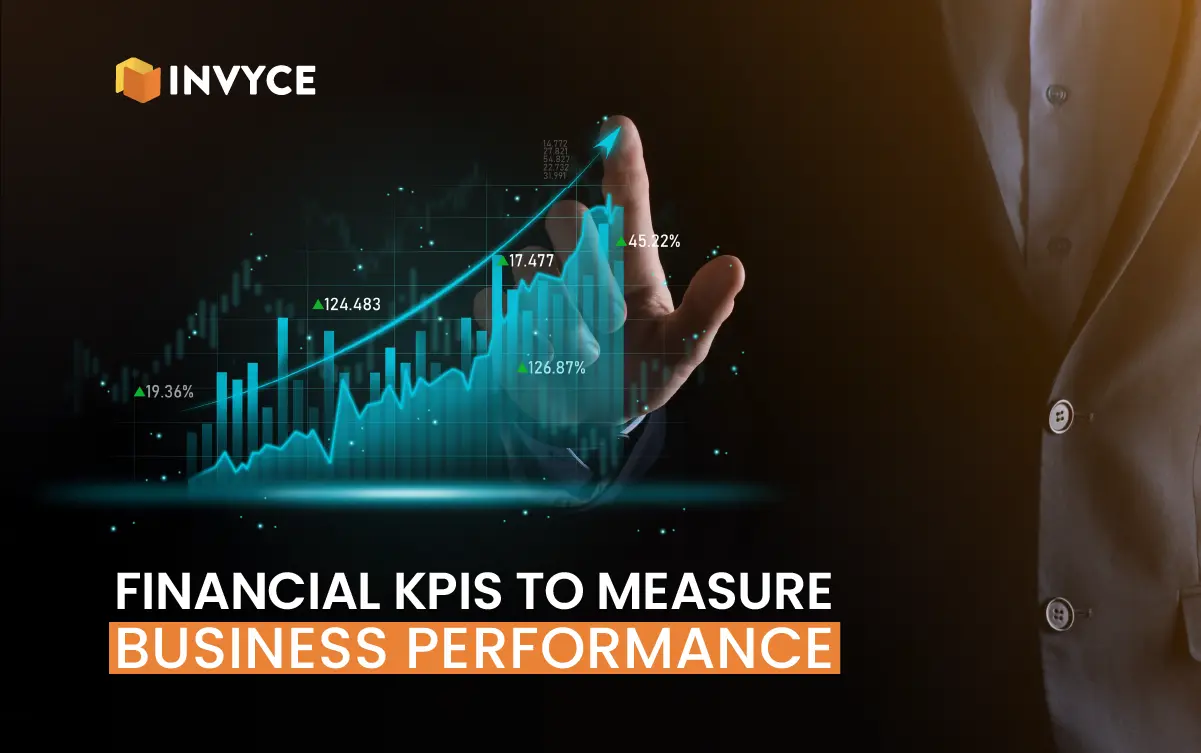21 Dec

Presume you’re in a pitch-black room, unsure of where to step, what obstacles creep, or even if you’re heading in the right direction. That’s what running a business without financial KPIs can feel like – a constant sense of uncertainty, fumbling in the dark. But just like a trusty flashlight, KPIs light the path, highlighting your progress, indicating potential pitfalls, and directing you toward success.
The following guide contains 40 best financial KPIs to help understand and evaluate the performance of your business – underlining the basics and importance of financial KPIs.
What are Financial KPIs?
Let’s understand it with an example. Imagine playing a game with your friends, but there are no scoreboards or goalposts! It’s hard to know if you’re winning, right?
KPIs are like the scoreboards and goalposts of your business. They’re clear markers that show you how you’re doing in important areas, like:
- How much money you’re making (revenue)
- How much profit you’re keeping (profitability)
- How well you’re using your resources (efficiency)
- How much money you have on hand (cash flow)
Just like looking at the scoreboard in a game, KPIs make your financial statements easy to understand. You can see if you’re on track to reach your goals, or if you need to adjust your strategy.
Why are KPIs So Important?
KPIs are important to:
- Track progress: Monitor if you’re hitting your targets, like sales goals, cost reductions in your business or financial markets
- Identify problems: Early warnings, like dipping profits, show areas needing attention.
- Make best decisions: KPIs guide future strategies, like investing in new markets or optimizing operations.
- Raise motivation: Seeing progress keeps your team fired up and focused on goals.
40 Key Financial Performance Indicators (KPIs)
Now that we’ve established the foundation of Financial KPIs, let’s now know metrics that directly reflect a company’s financial performance.
These KPIs represent a business’s income, sales performance, and growth potential. These are:
Revenue-related KPIs
These KPIs represent a business’s income, sales performance, and growth potential. These are:
1. Gross Revenue
Gross revenue is the total amount of money your business generates before deducting any expenses. It’s like the sum of all your sales, a raw measure of your overall sales effort. It’s like the total money deposited in your bank before you start spending.
2. Net Revenue
Net Revenue, on the other hand, is the income remaining after subtracting various deductions such as discounts, returns, and allowances from the Gross Revenue. This KPI provides a more accurate picture of a company’s actual earnings.
3. Revenue Growth Rate
This KPI tells you how fast your revenue is increasing or decreasing over a specific period (month, quarter, year). It’s like a speedometer for your business, showing if you’re accelerating, coasting, or even hitting the brakes. A positive growth rate indicates progress, while a negative one signifies potential red flags.
It can be calculated using the formula:
Revenue Growth Rate = (Current Revenue – Previous Revenue / Previous Revenue) x 100%
4. Customer Lifetime Value (CLV)
This KPI goes beyond individual sales and focuses on the long-term value of your customers. It estimates the total revenue you can expect from a customer throughout their relationship with your business.
It can be calculated using the formula:
CLV = Average Purchase Value x Purchase Frequency x Customer Lifespan / Customer Acquisition Cost
Profitability KPIs
These KPIs track how effectively your business turns revenue into profit, from big bites (Gross) to final crumbs (Net), measuring overall efficiency and return.
5. Gross Profit Margin
This KPI indicates the percentage of your income left after subtracting the direct costs of producing or cost of goods sold (COGS). It’s a measure of your pricing strategy and production efficiency.
It can be calculated using the formula:
Gross Profit Margin = (Revenue – COGS) / Revenue x 100%
Higher gross profit margins indicate effective cost management and a healthier bottom line.
6. Net Profit Margin
This takes things a step further, showing the percentage of your income remaining after deducting all operating expenses (not just COGS). It’s the ultimate measure of overall financial health and efficiency.
It can be calculated with the formula;
Net Profit Margin = (Net Profit) / Revenue x 100%
7. Operating Profit Margin
This KPI focuses solely on the efficiency of your core business operations, excluding financial expenses like interest or taxes. It reveals how well you’re managing your day-to-day operations to generate profit.
Operating Profit Margin = (Operating Profit) / Revenue) x 100%
8. Return on Investment (ROI)
Return on Investment is the measure of success for your investments. It calculates the profitability relative to the investment cost, providing a clear picture of your returns. Imagine it as the interest earned on your savings – the higher, the better.
ROI = (Profit from Investment) / Cost of Investment) x 100%
Liquidity KPIs
These metrics tell you how well your business can meet its short-term obligations and maintain financial stability, incorporating ratio analysis.
9. Current Ratio
The Current Ratio is a measure of your business’s short-term solvency, indicating its ability to cover immediate liabilities with available assets. It is t as checking if you have enough coins in your pocket to cover your daily expenses. It can be calculated with the formula;
Current Ratio = Current Assets / Current Liabilities
10. Quick Ratio
This takes things a step further by focusing on highly liquid assets, excluding inventory that might take longer to sell. It’s a more conservative measure, ideal for businesses with fluctuating inventory levels. Aim for a quick ratio of at least 1:1. This can be calculated as;
Quick Ratio = (Current Assets – Inventory) / Current Liabilities
11. Working Capital
Working Capital is the lifeblood of your day-to-day operations. It represents the difference between current assets and current liabilities, reflecting the funds available for daily activities. It can be calculated with the formula;
Working Capital = Current Assets−Current Liabilities
12. Cash Conversion Cycle (CCC)
This KPI measures how long it takes you to convert your inventory into cash and then use that cash to pay off your suppliers. A shorter CCC indicates efficient cash flow management, while a longer CCC could signify potential inefficiencies or liquidity concerns. CCC can be calculated with the below formula;
Cash Conversion Cycle = Days Inventory Outstanding + Days Sales Outstanding − Days Payable Outstanding
Efficiency KPIs
These metrics indicate the efficiency of your asset utilization, inventory management, and payment collection, ensuring smart work.
13. Asset Turnover
Asset Turnover is a measure of how efficiently your business uses its assets to generate revenue. It is similar to evaluating how well you make use of your tools and equipment for productive outcomes. You can calculate it with the formula;
Asset Turnover = Revenue / Average Total Assets
14. Inventory Turnover
Inventory Turnover assesses how quickly your company sells and replaces its inventory within a given period. It’s like checking how fast items fly off the shelves in your store. The formula is;
Inventory Turnover = Cost of Goods Sold / Average Inventory
15. Accounts Receivable Turnover
This KPI measures how quickly you’re collecting payments from customers. A faster turnover indicates efficient credit management and improved cash flow. You can calculate it with the formula;
Account Receivable Turnover = Total Credit Sales / Average Accounts Receivable
16. Days Sales Outstanding (DSO)
This KPI tells you the average number of days it takes to collect customer payments. A lower DSO indicates better credit terms and efficient collection processes. This can be calculated with the formula;
DSO = Average Accounts Receivable / Credit Sales x 365
Debt-related KPIs
These KPIs tell you how effectively you’re managing your debts and avoiding financial hazards. Which are;
17. Debt-to-Equity Ratio
The Debt-to-Equity Ratio assesses the proportion of debt used to finance your business compared to equity. It’s like weighing how much of your business is funded by loans compared to owner’s equity. This can be calculated by the formula;
Debt-to-Equity Ratio = Total Debt / Total Equity
18. Interest Coverage Ratio
The Interest Coverage Ratio measures your business’s ability to cover interest expenses with its operating income. It’s similar to ensuring you have enough income to cover your monthly interest payments. You can calculate it with the formula;
Interest Coverage Ratio = Operating Income / Interest Expense
19. Debt Service Coverage Ratio
The Debt Service Coverage Ratio gauges the business’s ability to repay its debt, considering both principal and interest payments. It’s like checking if you have enough income to cover all your debt-related expenses. Calculate it with the formula;
Debt Service Coverage Ratio = (Operating Income + Depreciation) / (Total Debt Payments)
20. Debt Ratio
The Debt Ratio calculates the proportion of a company’s debt-financed assets. It’s like assessing the weight of debt with your business’s total assets. You can calculate debt ratio with the formula;
Debt Ratio = Total Debts / Total Assets
Sustainability KPIs
This concerns resource usage, environmental footprint, and social performance, empowering you to build a business that benefits both people and the planet. These are;
21. Burn Rate
The Burn Rate measures how quickly your business is using up its available cash or capital. It’s like tracking the rate at which your resources are being consumed to sustain your operations. It can be calculated as;
Burn Rate = Number of Months Until Depletion / Total Operating Expenses
22. Break-even Point
The Break-even Point is the level of sales at which your business covers all its expenses and neither makes a profit nor incurs a loss. It’s like identifying the point at which your business becomes financially self-sufficient. You can calculate it as;
Break-even Point (in units) = Fixed Costs / Selling Price per Unit – Variable Cost per Unit
23. Cash Burn Rate
The Cash Burn Rate specifically focuses on the rate at which your business is using cash. It’s like observing how fast money is leaving your company. You can calculate the Cash Burn Rate with the mentioned formula;
Cash Burn Rate = Net Cash Outflows / Number of Months Until Depletion
24. Operating Cash Flow
Operating Cash Flow reflects the cash generated or used by a company’s core operating activities. It’s like measuring the cash inflow and outflow from day-to-day operations. The formula is;
Operating Cash Flow = Net Income + Non-cash Expenses + Changes in Working Capital
Growth-related KPIs
These KPIs show the progress towards ambitions, helping you to make the best decisions that ease your journey to even greater heights.
25. Return on Equity (ROE)
Return on Equity measures the profitability of a company to its shareholders’ equity. It’s like assessing the return generated for every dollar invested by shareholders. ROE can be calculated with the formula;
ROE = Net Income / Shareholders’ Equity
Return on Assets (ROA): A key performance indicator measuring a company’s efficiency in generating profit from its assets. Its formula is, ROA = Net Income / Total Average Assets.
While both ROA and ROE are profitability ratios, they measure different aspects of a company’s financial performance.
26. Earnings Per Share (EPS)
Earnings Per Share calculates the portion of a company’s profit allocated to each outstanding share of common stock. It’s like distributing the profit pie among shareholders. You can calculate it with;
EPS = Net Income / Number of Outstanding Shares
27. Dividend Yield
Dividend Yield assesses the annual dividend income as a percentage of the company’s stock price. It’s like understanding the return generated from dividend payments. You can calculate it with the formula;
Dividend Yield = Dividends per Share / Stock Price per Share x 100%
28. Retention Ratio
The Retention Ratio represents the percentage of earnings retained by the company instead of being distributed as dividends. It’s like understanding how much of the profit is reinvested back into the business. It can be calculated with the formula;
Retention Ratio = 1 − Dividend Payout Ratio
Cost Management KPIs
These KPIs show the expenditure patterns, highlighting areas for potential savings and empowering you to navigate the financial terrain.
29. Cost of Goods Sold (COGS)
This represents the direct costs associated with producing or selling goods or services. It includes expenses like raw materials, labor, and direct overhead. A lower COGS indicates efficient production and better control over your bottom line. You can calculate it with the formula;
COGS = Opening Inventory + Purchases − Closing Inventory
30. Operating Expenses Ratio
The Operating Expenses Ratio measures the proportion of revenue used to cover operating costs. It’s like assessing how much of the revenue pie is consumed by day-to-day business operations. You can calculate it as;
Operating Expenses Ratio = Operating Expenses / Net Revenue x 100%
31. Overhead Costs
Overhead Costs encompass all indirect expenses not directly tied to the production of goods or services. It’s like considering all the hidden costs in running your business efficiently.
Overhead Costs = Indirect Costs like Rent, Utilities, etc.
32. Cost Per Acquisition (CPA)
This represents the cost of acquiring a new customer. It includes marketing, advertising, and sales expenses involved in bringing in each new customer. It can be calculated as;
CPA = Total Marketing Costs / Number of Acquired Customers
Productivity KPIs
These KPIs are for the effectiveness of the workforce to optimize your human capital for maximum impact.
33. Employee Productivity
Employee Productivity measures the output of work per employee, reflecting how efficiently your workforce is performing. It’s like evaluating the efficiency of each player on a sports team. It can be evaluated using the formula;
Employee Productivity = Output / Number of Employees
34. Revenue per Employee
Revenue per Employee assesses how much revenue each employee generates for the company. It’s like calculating the contribution of each team member to the overall financial success. You can use the below formula;
Revenue per Employee = Total Reve / Number of Employees
35. Profit per Employee
Profit per Employee goes a step further, measuring the net profit contribution of each employee. It’s like understanding the individual impact on the company’s bottom line. Use the following formula to evaluate;
Profit per Employee = Net Profit / Number of Employees
36. Employee Satisfaction Index
The Employee Satisfaction Index measures the contentment and engagement of the workforce. It’s like taking the pulse of your team’s overall happiness and morale.
Employee Satisfaction Index = Number of Satisfied Employees / Total Number of Employees x 100%
Risk Management KPIs
These metrics deal with the concerns of potential risks, ensuring the business stays resilient in the face of uncertainties.
37. Value at Risk (VaR)
Value at Risk estimates the potential loss due to market risks within a specified confidence level. It’s like having a financial safety net, indicating the worst-case scenario your business might face. It can be calculated as;
VaR = Portfolio Value x Volatility x Z-Score
38. Risk-Adjusted Return on Capital (RAROC)
Risk-adjusted return on Capital evaluates the return generated by an investment relative to the risk associated with it. It’s like assessing the profitability considering the level of risk involved.
RAROC = Risk-Adjusted Return / Capital at Risk
39. Beta
Beta measures the sensitivity of an investment’s returns to market movements. It’s like understanding how closely your business performance aligns with overall market trends. Calculate it using the formula;
Beta = Covariance between Asset and Market / Variance of the Market
40. Sharpe Ratio
The Sharpe Ratio evaluates an investment’s return adjusted for the level of risk taken to achieve it. This metric, considering factors like volatility and standard deviation, helps investors assess how well an investment compensates for the associated risks.
Investment’s risk-adjusted return refers to the return achieved by an investment while accounting for the level of risk involved. This measurement considers various factors like volatility, alpha, beta, and standard deviation.
The formula below quantifies risk-adjusted return and help compare and choose investments.
Sharpe Ratio = Portfolio Return – Risk Free Rate / Portfolio Standard Deviation
Wrapping Up
Throughout the financial KPIs guide, we explored a substantial set, from Revenue-related metrics to Risk Management indicators, providing a comprehensive view of business health.
Healthy financial ratios, optimized operations, and managed risk are not just short-term goals – they’re the foundation for a profitable future. Build investor confidence, attract talent, and weather industry storms by prioritizing financial health.
Financial Health Indicators offer a snapshot of stability, while Operational Performance metrics focus on day-to-day efficiency. Implementing Financial KPIs is an ongoing process, driven by SMART goals, industry relevance, technology, and best monitoring systems.
Marketing Writer & Editor
Related Post
Copyright © 2024 – Powered by uConnect



Naveed Wali Khan